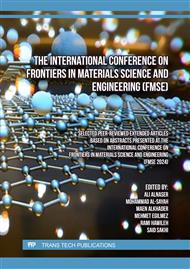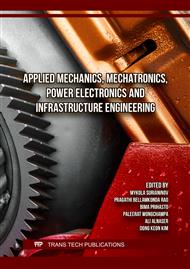[1]
Federation International De l'Automobile; (2019). Safety equipment for cross country vehicles. Appendix J article 283.
Google Scholar
[2]
Nassiopoulos, E.;Njuguna, J.; (2010). An assessment of the side impact protection systems (SIPS) for racing drivers in motorsport rallying championships. Centre for Automotive Technology, Department of Sustainable Systems, Cranfield University, Bedfordshire.
Google Scholar
[3]
Pavlovic, A.; Zivkovic, M.; (2016). Roll cage design and validation for a rally vehicle. FME Transactions. 44. 398-404.
DOI: 10.5937/fmet1604398P
Google Scholar
[4]
Schrader, S.; (2017). Speed limits. Retrieved July 14 2020 from Jalponik Website.
Google Scholar
[5]
Hassan, M. Z.; Brooks, P. C.; Barton, D. C.; (2009). A predictive tool to evaluate disk brake squeal using a fully coupled thermo-mechanical finite element model. International journal of vehicle design, 51(1-2), 124-142.
DOI: 10.1504/ijvd.2009.027118
Google Scholar
[6]
Belhocine, A.; Bouchetara, M.; (2012). Thermal analysis of a solid brake disc. Applied Thermal Engineering, 32, 59-67
DOI: 10.1016/j.applthermaleng.2011.08.029
Google Scholar
[7]
Lajqi, S.; Pehan, S.; (2012). Designs and optimizations of active and semi-active non linear suspension systems for a terrain vehicle. Strojniški vestnik-Journal of Mechanical Engineering, 58(12), 732-743
DOI: 10.5545/sv-jme.2012.776
Google Scholar
[8]
Saurabh, Y. S.; Kumar, S.; Jain, K. K.; Behera, S. K.; Gandhi, D.; Raghavendra, S.; Kalita, K.; (2016). Design of suspension system for formula student race car. Procedia Engineering, 144, 1138-1149.
DOI: 10.1016/j.proeng.2016.05.081
Google Scholar
[9]
Gysen B.L.; Paulides J.J.; Janssen, J.L.; Lomonova, E.A.; (2010). Active electromagnetic suspension system for improved vehicle dynamics. IEEE Transactions on Vehicular Technology, 59(3), 1156-1163.
DOI: 10.1109/tvt.2009.2038706
Google Scholar
[10]
Cage material; (n.d.). T45 carbon steel. Retrieved July 14 2020 from Custom Cages Company website.
Google Scholar
[11]
Sati, B. K.; Upreti, P.; Tripathi, A.; Batra, S.; (2016). Static and dynamic analysis of the roll cage for an All-Terrain vehicle. Imperial Journal of Interdisciplinary Research (IJIR), 2(6), 43-51.
Google Scholar
[12]
Adamowizc, A.; (2016). Finite element analysis of the 3D thermal stress state in a brake disk. Journal of Theoretical and Applied Mechanics, 54(1), 205-218.
DOI: 10.15632/jtam-pl.54.1.205
Google Scholar
[13]
Kulkarni, A.; Hegade, K.; Karale, O.; Joshi, P. S.; (2016). Coupled thermal and structural analysis of brake disc rotor manufactured from aluminum metal matrix composite (AMMC) reinforced with silicon carbide. Imperial Journal of Interdisciplinary Research 2(6), 1188-1194.
Google Scholar
[14]
Manjunath, T.V.; Suresh, P.M.; (2013). Structural and thermal analysis of rotor disc of disc brake. International Journal of Innovative Research in Science, Engineering and Technology, 2(12), 2319-8753.
Google Scholar
[15]
Sam, Y. M.; Osman, J. H.; Ghani, M. R. A.; (2004). A class of proportional-integral sliding mode control with application to active suspension system. Systems & Control Letters, 51(3-4), 217-223.
DOI: 10.1016/j.sysconle.2003.08.007
Google Scholar
[16]
Terefe, T. O.; Lemu, H. G.; (2018). Solution approaches to differential equations of mechanical system dynamics: A case study of car suspension system. Advances in Science and Technology Research Journal, 12.
DOI: 10.12913/22998624/85662
Google Scholar
[17]
Atherden, M. J.; Daniel, W. J. T.; (2004). Formula SAE shock absorber design. University of Queensland.
Google Scholar
[18]
Kelly, S. G.; (1996). Schaum's outline of theory and problems of mechanical vibrations/S. Graham.
Google Scholar
[19]
Audi A3 presentation; (2016). Audi Service department. [Catalogue].
Google Scholar



